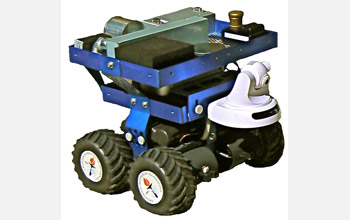Multimedia Gallery
Surrogate Robot for the Blind
CYCLOPS, a remote-controlled robot developed by scientists at the California Institute of Technology (Caltech), can simulate the "visual" experience of a blind person who has been implanted with a visual prosthesis, such as an artificial retina. Scientists hope that this approach may one day give blind persons the freedom of independent mobility.
Artificial retinas are comprised of a silicon chip that is studded with a number of electrodes that directly stimulate retinal nerve cells. Artificial retinas capture images using a miniature camera, placed either externally or internally. The captured images are processed and passed along to the implanted silicon chip's electrode array. The chip directly stimulates the eye's functional retinal ganglion cells, which carry the image information to the vision centers in the brain.
Only a limited number of people have been implanted with artificial retinas worldwide, and testing can be time consuming and tiring. "We can use CYCLOPS in lieu of a blind person," says Wolfgang Fink, a visiting associate in physics at Caltech, who developed CYCLOPS with Mark Tarbell, also a Caltech visiting scientists. Work was conducted at Caltech's Visual and Autonomous Exploration Systems Research Lab. "We can equip it with a camera just like what a blind person would have with a retinal prosthesis," says Fink. "And that puts us in the unique position of being able to dictate what the robot receives as visual input." CYCLOPS is the first such device to emulate what a blind person can see with an implant.
The development of CYCLOPS and potential uses were described in a paper by Fink and Tarbell, published online in the journal Computer Methods and Programs in Biomedicine, entitled "CYCLOPS: A mobile robotic platform for testing and validating image processing and autonomous navigation algorithms in support of artificial vision prostheses." The work described in the paper was supported by a grant from the National Science Foundation (EEC 03-10723).
The learn more about this research, see the Caltech press release "Caltech Scientists Create Robot Surrogate for Blind Persons in Testing Visual Prostheses." (Date of Image: 2008)
Credit: Caltech/Wolfgang Fink, Mark Tarbell
Images and other media in the National Science Foundation Multimedia Gallery are available for use in print and electronic material by NSF employees, members of the media, university staff, teachers and the general public. All media in the gallery are intended for personal, educational and nonprofit/non-commercial use only.
Images credited to the National Science Foundation, a federal agency, are in the public domain. The images were created by employees of the United States Government as part of their official duties or prepared by contractors as "works for hire" for NSF. You may freely use NSF-credited images and, at your discretion, credit NSF with a "Courtesy: National Science Foundation" notation.
Additional information about general usage can be found in Conditions.
Also Available:
Download the high-resolution JPG version of the image. (405 KB)
Use your mouse to right-click (Mac users may need to Ctrl-click) the link above and choose the option that will save the file or target to your computer.



